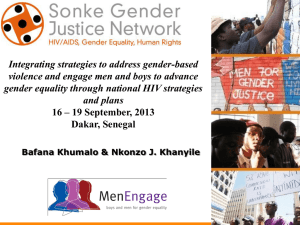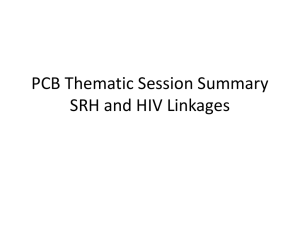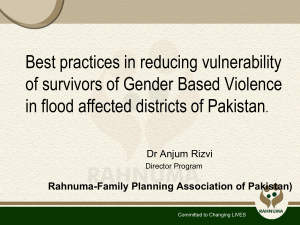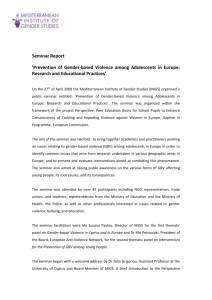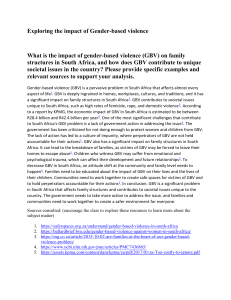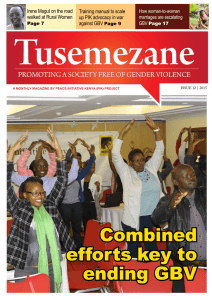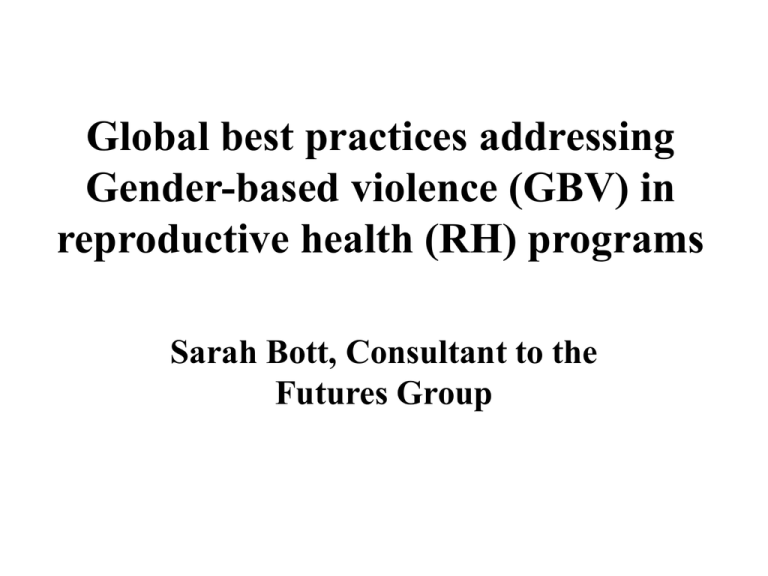
Global best practices addressing
Gender-based violence (GBV) in
reproductive health (RH) programs
Sarah Bott, Consultant to the
Futures Group
Why Should RH Programs
Address GBV
Prevention:
• Can reframe GBV as a public health problem
• Can apply public health approaches to prevention
Response:
•
•
•
•
Can identify women in danger before violence escalates
Increase access to comprehensive survivor services
Reduce negative health outcomes of GBV
Assist survivors to access help / services/ legal protections
Improve SRH outcomes:
• Improve t he effectiveness of HIV prevention
• Improve sexual/ reproductive health programs for youth
• Provider better quality, integrated health care for women
What Do We Mean By Best Practices?
•
•
•
•
Growing number of initiatives
Limited evidence of effectiveness
Lack of investment in rigorous evaluation
Methodological challenges, e.g.:
-Hard to define / measure indicators of success
-Results often require long term follow-up
-changing violence levels hard to measure/interpret
-Unclear whether attitudes proxy for behavior
At Least 4 Different Levels
•
•
•
•
Laws and public policies
Institutional reform: health services
Mobilizing communities
Communication for behavior
change / changing gender norms
Health Services: Common Problems
• Health professionals not trained to recognize
GBV as a public health issue
• Providers share negative attitudes about women
and GBV common in society
• Health care orgs not equipped with infrastructure
policies, training, supplies, referral networks
• Legal protections and social services for
survivors often lacking in low-income countries
The Systems Approach
•Institutional commitment
•Sexual harassment policies
•Infrastructure that allows privacy
•Policies to protect confidentiality
•Staff training and support
•Referral networks to community services
•Care Protocols for survivors
•Supplies such as EC and STI prophylaxis
•Data collection systems
Bottom Line: GBV Issues are
Integral to Women’s Health
Attention to GBV needs to be incorporated into:
– University training of health professionals
– Efforts to improve SRH quality of care
– SRH care protocols, including HIV/AIDS and
SRH programs for adolescents
– Tools for monitoring and evaluating quality
of women’s health care
Routine Screening / Enquiry
•
•
•
Issue consumes much of the literature
Worldwide controversy on risks / benefits
Definitive evidence of net benefit probably
unrealistic (example of mammograms)
Two clear lessons:
a) Institutional reforms should come first
b) All RH programs should be prepared to
respond to GBV, not just those that screen
Role of SRH Programs in Improving
Laws and Public Policies
• SRH programs can reframe GBV as public health
• Educate / train policy makers, law enforcement
• Advocate to improve policies specific to SRH:
– Survivors’ access to EC, forensic exams, STI/HIV
prophylaxis;
– Sensible reporting laws for providers;
– Coordinate law enforcement and medical services
– Improve the medico-legal system
SRH Policy Reform: MedicoLegal System, South Africa
•
•
•
•
Researchers documented dysfunctional system
Advocates lobbied for legal and policy reform
The government changed laws and regulations
Government implemented forensic nursing
system and other reforms
• Evaluation of impact is pending . . .
Community Mobilization
• Has been shown effective for prevention
• Appears to be essential for improving the
service response for survivors
• Best if takes a multi-sectoral approach
• Best known / well documented here today
• So what is role of RH programs?
– Some documented successes used PLA in SRH
framework (Reprosalud, Stepping Stones)
– RH programs can frame GBV as public health
Promising Examples of
Communication for Social Change
• Education-entertainment (Soul City, South Africa/ Sexto
Sentido, Nicaragua)
• Life skills education for youth (New Visions, Egypt)
• HIV/AIDS prevention programs that address gendernorms (Program H, Latin America))
Unfortunately, many youth SRH / HIV prevention
programs for youth assume that sexual activity is a
voluntary “decision”; fail to address sexual coercion
Lessons re: Communication for
Social Change
• Easiest to change norms and behavior
among youth
• HIV/AIDS prevention more effective if
address GBV—e.g. sexual coercion
• Essential to target boys and men as well as
girls and women
• Prevention focused solely on potential
victims generally fails
Evaluation Challenges:
Prevention
• Hard to separate contribution of multiple
strategies
• Changing violence levels hard to measure and
interpret
• Attitudes easier to measure than behavior, but
may not be adequate proxy for perpetration
• Individual outcomes easier to measure than
community-level changes

